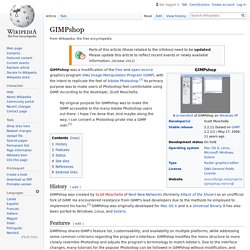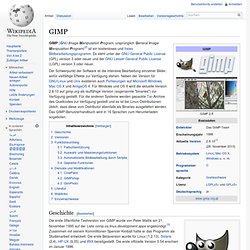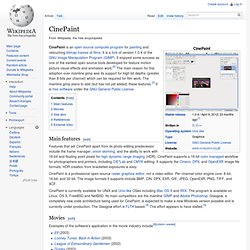

GIMPshop.com - A GIMP hack by Scott Moschella. GIMPshop. GIMPshop was a modification of the free and open source graphics program GNU Image Manipulation Program (GIMP), with the intent to replicate the feel of Adobe Photoshop.[1] Its primary purpose was to make users of Photoshop feel comfortable using GIMP.

According to the developer, Scott Moschella: My original purpose for GIMPshop was to make the GIMP accessible to the many Adobe Photoshop users out there. I hope I’ve done that. And maybe along the way, I can convert a Photoshop pirate into a GIMP user.[2] History[edit] Features[edit] GIMPshop shares GIMP's feature list, customisability, and availability on multiple platforms, while addressing some common criticisms regarding the program's interface: GIMPshop modifies the menu structure to more closely resemble Photoshop and adjusts the program's terminology to match Adobe's. For Mac OS X, GIMPshop is compatible only with Panther (10.3.x) and Tiger (10.4.x).
Status[edit] In a March 2014 discussion,[9] Moschella states: GIMPshop. GIMP (GNU Image Manipulation Program, ursprünglich General Image Manipulation Program)[2] ist ein kostenloses und freies Bildbearbeitungsprogramm.

Es steht unter der GNU General Public License (GPL) version 3 oder neuer und der GNU Lesser General Public License (LGPL) version 3 oder neuer. Geschichte[Bearbeiten] Die Figur trägt den Namen Wilber Als Peter Mattis von Motif auf eine freie Lösung umsteigen wollte, entwickelte er sein eigenes Toolkit GTK+, das inzwischen als offenes Projekt ein Eigenleben führt und beispielsweise in der Desktop-Umgebung Gnome verwendet wird. Gimphoto - free Photoshop alternative for photo and image editor. GimPhoto. GimPhoto is a modification of the free and open source graphics program GNU Image Manipulation Program (GIMP), with the intent to be a free alternative to Adobe Photoshop.[1] It has a new menu layout, new brushes and gradient sets.

Its primary purpose is to enhance GIMP in terms of user interface, use of the best plugins and other resources combined with the latest stable version of GIMP. Because the new menu layouts are much closer to Photoshop's, adaptation from Photoshop is much quicker than GIMP.[2] Future development[edit] Since GimPhoto is a one-man effort, the developer has chosen to look for a long lasting, stable release of GIMP, before creating a new version of GimPhoto. Consequently the 2.6 branch may be skipped altogether and the 2.8 branch may be the target for the next release of GimPhoto. See also[edit] References[edit] External links[edit] Official GimPhoto webpage. CinePaint — Open source deep paint software. CinePaint. Main features[edit] Features that set CinePaint apart from its photo-editing predecessor include the frame manager, onion skinning, and the ability to work with 16-bit and floating point pixels for high dynamic range imaging (HDR).

CinePaint supports a 16-bit color managed workflow for photographers and printers, including CIE*Lab and CMYK editing. It supports the Cineon, DPX, and OpenEXR image file formats. HDR creation from bracketed exposures is easy. CinePaint is a professional open-source raster graphics editor, not a video editor. CinePaint is currently available for UNIX and Unix-like OSes including Mac OS X and IRIX. Movies[edit] Examples of the software's application in the movie industry include[6][citation needed]: See also[edit] Comparison of raster graphics editors. CinePaint. CinePaint (ehemals Film Gimp) ist eine professionelle Grafiksoftware für Filme.

Da bei der Entwicklung von CinePaint Code aus unterschiedlichen anderen Projekten eingeflossen ist, werden die Quelltexte entsprechend uneinheitlich unter verschiedenen freien Lizenzen veröffentlicht (GPL, LGPL, BSD, MPL). Neben Rhythm & Hues tragen die Studios von Sony Pictures Imageworks, ILM und DreamWorks Quelltext zu dem Projekt bei. Geschichte[Bearbeiten] Filme, die CinePaint nutzen[Bearbeiten] Von folgenden Filmen ist bekannt, dass CinePaint im Produktionsprozess genutzt wurde:
CinePaint WiKi.